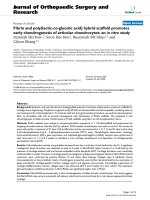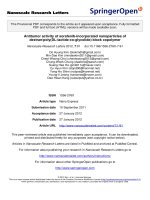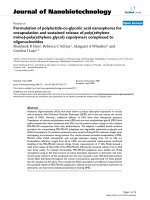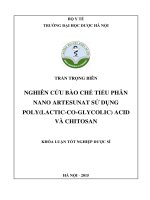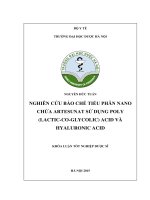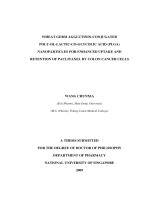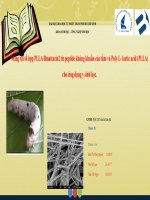Wheat germ agglutinin conjugated poly dl lactic co glycolic acid (PLGA) nanoparticles for enhanced uptake and retention of paclitaxel by colon cancer cells
Bạn đang xem bản rút gọn của tài liệu. Xem và tải ngay bản đầy đủ của tài liệu tại đây (3.56 MB, 231 trang )
WHEAT GERM AGGLUTININ-CONJUGATED
POLY-DL-LACTIC-CO-GLYCOLIC ACID (PLGA)
NANOPARTICLES FOR ENHANCED UPTAKE AND
RETENTION OF PACLITAXEL BY COLON CANCER CELLS
WANG CHUNXIA
(B.S.(Pharm), Shan Dong University)
(M.S. (Pharm), Peking Union Medical College)
A THESIS SUBMITTED
FOR THE DEGREE OF DOCTOR OF PHILOSOPHY
DEPARTMENT OF PHARMACY
NATIONAL UNIVERSITY OF SINGAPORE
2009
Acknowledgements
I would like to express my heartfelt gratitude to my supervisors, Associate Professor
Paul, Ho Chi Lui and Lim Lee Yong for their precious guidance, helpful advice and
enormous support and patience during my PhD study. Their enthusiasm and
originality in research will inspire and benefit me the whole life. Without them this
thesis would not have been possible.
Thanks to Department of Pharmacy, National University of Singapore for providing
the financial support for me to pursue my PhD degree and thanks to the PhD
committee for their precious time to read the thesis. Sincere gratitude is also
expressed to all the lab officers, including Swee Eng, Sek Eng, Mr. Tang, Tang Booy,
Josephine and Madam Loy for their technical help and support.
To all my friends, past and present, especially Huang Meng, Haishu, Yupeng, Siok
Lam, Hanyi, Weiqiang, Dahai, Ma Xiang, Yang Hong, Shili, Wang Zhe, Tarang.
Thank you for your support, discussions, meetings, outings and jokes.
To my parents, my husband, my son, my sisters, thank you for your patience,
encouragement, selfless support and putting up with all my frustration and emotion
during the journey of my study all along.
I
TABLE OF CONTENTS
Content Page
ACKNOWLEDGEMENTS Ⅰ
TABLE OF CONTENTS Ⅱ
SUMMARY II
LIST OF TABLES II
LIST OF FIGURES III
LIST OF ABBREVIATIONS XVII
LIST OF PUBLICATIONS XIX
Chapter 1 Introduction 1
1.1 Chemotherapy for colon cancer 2
1.1.1 Colon cancer 2
1.1.2 Anticancer agents 4
1.1.3 Paclitaxel 7
1.1.4 Targeted delivery of anticancer agents 10
1.2 Polymeric nanoparticles 14
1.2.1 Nanoparticulate systems for drug delivery 14
1.2.2 PLGA nanoparticles 18
1.2.3 Cellular uptake of nanoparticles 25
II
1.3 Wheat germ agglutinin for drug targeting 28
1.3.1 Wheat germ agglutinin 28
1.3.2 Applications 32
1.4 Barriers for intracellular drug delivery 35
1.4.1 Biological barriers 35
1.4.2 Strategies to enhance intracellular accumulation 37
1.5 Statement of purpose 39
Chapter 2 Screening for wheat germ agglutinin-binding glycoprotein in colon
cell models 43
2.1 Introduction 44
2.2 Materials 47
2.3 Methods 48
2.3.1 Basic theory of lectin blot analysis 48
2.3.2 Cell culture 50
2.3.3 Whole cell protein and cell membrane protein extraction 51
2.3.4 Protein quantification 53
2.3.5 Lectin blot analysis 54
2.4 Results and Discussion 54
2.4.1 Protein quantification 54
2.4.2 Lectin blot analysis 55
III
2.5 Conclusion 57
Chapter 3 Uptake and cytotoxicity of wheat germ agglutinin in colon cell
models 58
3.1 Introduction 59
3.2 Materials 62
3.3 Methods 63
3.3.1 Cell culture 63
3.3.2 Cytotoxicity of WGA 64
3.3.3 Protein quantification 65
3.3.4 Uptake of FITC-WGA (fWGA) 66
3.3.5 Visualization of fWGA cellular uptake 67
3.3.6 Statistical analysis 69
3.4 Results 69
3.4.1 In vitro cytotoxicity profile of WGA against colon cell lines 69
3.4.2 Uptake of WGA by colon cell lines 71
3.4.3 Laser scanning confocal photomicrographs 75
3.5 Discussion 77
3.6 Conclusion 83
Chapter 4 Evaluation of anticancer activity of wheat germ agglutinin
IV
-conjugated paclitaxel-loaded PLGA nanoparticles 85
4.1 Introduction 86
4.2 Materials 89
4.3 Methods 90
4.3.1 Preparation of WGA-conjugated, paclitaxel-loaded PLGA nanoparticles 90
4.3.2 Characterization of nanoparticles 94
4.3.2.1 Particle size, zeta potential and morphology 94
4.3.2.2 WGA loading efficiency 95
4.3.2.3 Determination of paclitaxel loading efficiency 96
4.3.2.4 In vitro drug release 96
4.3.3 In vitro cytotoxicity of blank WGA-conjugated PLGA nanoparticles 97
4.3.4 Uptake of blank fWGA (fWN) and fBSA- (fBN) conjugated
PLGA nanoparticles 98
4.3.5 Antiproliferation activity of paclitaxel 99
4.3.6 Cellular accumulation and efflux of paclitaxel 100
4.3.7 Visualization of cell-associated nanoparticles 102
4.3.8 Cell morphological and nucleus fragmentation examination 103
4.3.9 Cell cycle analysis by flow cytometry 104
4.3.10 Cellular trafficking of WNP 106
4.3.11 Statistical analysis 107
4.4 Results 107
V
4.4.1 Characterization of WGA-conjugated paclitaxel-loaded PLGA
nanoparticles 107
4.4.1.1 Particle size, zeta potential and morphology 107
4.4.1.2 WGA loading efficiency 109
4.4.1.3 Determination of paclitaxel loading efficiency 109
4.4.1.4 In vitro drug release 110
4.4.2 In vitro cytotoxicity profile of blank WGA-conjugated PLGA
nanoparticles 110
4.4.3 Uptake of blank fWGA-conjugated PLGA nanoparticles 113
4.4.4 Antiproliferation activity of paclitaxel 115
4.4.5 Antiproliferation activity of paclitaxel-loaded PLGA nanoparticles 117
4.4.6 Cellular accumulation and efflux of paclitaxel 121
4.4.7 Visualization of cell-associated nanoparticles 123
4.4.8 Cell morphology 125
4.4.9 Cell cycle analysis 128
4.4.10 Cellular trafficking of WGA-conjugated PLGA nanoparticles 131
4.5 Discussion 136
4.6 Conclusion 142
Chapter 5 Effect of mucin on the uptake of nanoparticles 144
5.1 Introduction 145
VI
5.2 Materials 150
5.3 Methods 150
5.3.1 Cell culture 150
5.3.2 Alcian blue (AB) and periodic acid Schiff (PAS) staining 151
5.3.3 Lectin blot 151
5.3.4 Cytotoxicity of WGA 152
5.3.5 Uptake of FITC-WGA 152
5.3.6 Anti-proliferation activity of paclitaxel-loaded nanoparticles 152
5.3.7 Cellular uptake and efflux of paclitaxel 153
5.3.8 Diffusion measurements (FRAP) 154
5.3.9 Visualization of fWNP uptake by LS174T cells 156
5.3.10 Statistical analysis 156
5.4 Results 156
5.4.1 Alcian blue (AB) and periodic acid Schiff (PAS) staining 156
5.4.2 Lectin blot analysis 157
5.4.3 In vitro cytotoxicity profile of WGA against LS174T 158
5.4.4 Uptake of FITC-WGA 159
5.4.5 Antiproliferation activity of paclitaxel-loaded nanoparticles 160
5.4.6 Cellular uptake and efflux of paclitaxel 161
5.4.7 Diffusion measurements (FRAP) 163
5.4.8 Visualization of fWNP uptake by LS174T cells 165
VII
5.5 Discussion 166
5.6 Conclusion 172
Chapter 6 Conclusions 173
Chapter 7 Future directions 181
Chapter 8 References 185
VIII
Summary
The ideal goal of cancer chemotherapy is to destroy cancer cells without harming
healthy cells. Most current anticancer drugs cannot greatly differentiate between
cancerous and normal cells. This leads to systemic toxicity and adverse effects.
Targeted delivery of anticancer agents could offer a more efficient and less harmful
solution to overcome this drawback. The purpose of this project was to confirm the
hypothesis that conjugation of WGA to PLGA nanoparticles loaded with paclitaxel
(WNP) could improve the delivery of paclitaxel to colonic cancer cells.
Glycosylation patterns of representative colon cancer cells (Caco-2 and HT-29 cells)
and normal cells (colon fibroblasts, CCD-18Co cells) were first investigated. Our
results confirmed the higher expression levels of WGA-binding glycoproteins
(N-acetylglucosamine and sialic acid) in the Caco-2 and HT-29 cells, than in the
CCD-18Co cells. Most of the WGA-recognizable glycoproteins in the Caco-2 and
HT-29 cells had molecular weight > 75 kDa, whereas the CCD-18Co cells showed an
apparent lack of expression of such large proteins. The ranking order of expression of
WGA-recognizable glycoproteins in the three cell lines was HT-29 > Caco-2 >
CCD-18Co cells.
In vitro cytotoxicity and cellular uptake studies were then carried out to evaluate the
potential of WGA for targeted activity against the colon cell models. WGA exhibited
IX
different degrees of cytotoxicity against the Caco-2, HT-29 and CCD-18Co cells, but
showed anti-proliferative activity in all 3 cell lines at concentrations ≥ 50 µg/ml.
Cellular uptake of fWGA ranked in the order of Caco-2 > HT-29 > CCD-18Co cells.
The higher binding of fWGA to the malignant cells may be associated with the greater
expression of WGA-recognizable glycoproteins in these cells relative to the colon
fibroblast cells.
WGA was conjugated onto the surface of paclitaxel-loaded PLGA nanoparticles to
prepare the WNP formulation. Cellular uptake and cytotoxicity of WNP were
evaluated in the three colon cell lines. In vitro anti-proliferation studies suggested that
the incorporation of WGA enhanced the cytotoxicity of the paclitaxel-loaded PLGA
nanoparticles against the cancerous Caco-2 and HT-29 cells. Paclitaxel uptake from
the WNP formulation at 2h incubation was the highest in the Caco-2 cells compared
to the other two cell lines. Caco-2 and HT-29 cells showed preferential uptake of
WNP compared to PNP, suggesting that WGA conjugation to the PLGA nanoparticles
was advantageous in facilitating the nanoparticle uptake by the cultured colon cancer
cells. The greater efficacy of WNP correlated well with the higher cellular uptake and
sustained intracellular retention of paclitaxel associated with the formulation, which
again might be attributed to the over-expression of N-acetyl-D-glucosamine-
containing glycoprotein on the colon cell surface. About 30% of the endocytosed
WNP was observed in the late endo-lysosomes, but fluorimetric measurements
X
XI
indicated successful escape of the WNP from the endo-lysosome compartment into
the cytosol with increasing incubation time.
To evaluate the effect of mucin glycoprotein on the cellular uptake of WNP, the
uptake experiments were repeated using a mucin-secreting cell line, LS174T. The
LS174 cells showed no significant differences in paclitaxel uptake from the WNP
formulation on day 3 of culture compared to day 6 of culture, despite the significantly
higher production of mucin by day 6. The presence of mucin may therefore not be a
barrier for the cellular uptake of WGA-conjugated nanoparticles. FRAP results
showed that fWNP was capable of diffusing in the mucin layer, although the diffusion
rate was slowed down by the viscous mucin. This diffusion capability allowed the
fWNP to remain mobile in the mucin layer and enabled the particles to be transported
into the cells. Interaction between the mucin glycoprotein and WGA is postulated to
serve as a bridge between WNP and the colon cancer cells under the mucin layer.
On the basis of these results, it may be concluded that WNP has the potential to be
applied as a targeted delivery platform for paclitaxel in the treatment of colon cancer.
LIST OF TABLES
Table Page
1.1 Microtubule-targeted drugs, their binding sites on tubulin, and their
stages of clinical development 5
1.2 Examples of polymeric nanoparticles in clinical development 16
4.1 Size and zeta potential of PLGA nanoparticles before and after conjugation
with WGA (Data represent mean ± SD, n=3) 108
4.2 IC
50
values of paclitaxel formulated as WNP, PNP and P/CreEL. IC
50
values were evaluated after 24 and 72 h exposure and the results represent
Mean ± SD values (µg/ml) of three independent experiments, each
performed in triplicate. ‘*’ means statistical significance compared to
P/CreEL, ‘^’ means statistical significance between the WNP and PNP
formulations 120
4.3 Colocalisation of FITC-WNP (green) and endosome/lysosome (red) in
Caco-2 cells. Colocalisation percentage is the percentage of voxels which
have both red and green intensities above threshold, expressed as a percentage
of the total mumber of pixels in the image 134
5.1 Mobile fraction and half-time to steady state fluorescence obtained from the
FRAP plots for fWGA, fWNP and fBSA-NP particles in PBS and the mucin
layer of LS174T samples (Mean ± SD, n=4) 165
XII
LIST OF FIGURES
Figure Page
1.1 Molecular structure of paclitaxel 7
1.2 Chemical structure of PLGA and its degradation products 19
1.3 Schematic drawing of steps involved in cytosolic delivery of therapeutics
using polymeric nanoparticles (NPs). (1) Cellular association of NPs, (2)
Internalization of NPs into the cells by endocytosis, (3) Endosomal escape
of NPs, (4) Release of therapeutic in cytoplasm, (5) Cytosolic transport of
therapeutic agent, (6) Degradation of drug either in lysosomes or in cytoplasm,
(7) Exocytosis of NPs 26
1.4 Structure of N-acetylglucosamine–wheat germ agglutinin complex: red, N-
acetylglucosamine; blue / green, wheat germ agglutinin 29
1.5 Possible pathways for lectin-mediated drug delivery to enterocyte as
exemplified by WGA 30
2.1 Lectin blot Scheme. Biotinylated WGA attaches to the glycoprotein,
the biotin label is amplified with avidin, and the complex is visualized
with chemiluminescence. 50
2.2 Mem-PER reagent protocol 52
2.3 Lectin blot analysis of (a) cell membrane proteins and (b) intracellular
proteins in Caco-2 (Lane 1), HT-29 (Lane 2) and CCD-18Co (Lane 3) cells 56
3.1 Biotransformation of MTT to formazan in cells 64
3.2 In vitro cytotoxicity profiles of WGA against (A) Caco-2; (B) HT-29
and (C) CCD-18Co cells. WGA was applied at loading concentrations
of 0.1, 1, 5, 10, 50, 100 and 200 μg/ml for periods ranging from 4 to
72h. Cell viability determined by the MTT assay was expressed as a
percent of that obtained for cells exposed to culture medium. SDS
served as positive control. Data represent mean ± SD, n=6 70
3.3 Uptake of fWGA by (A) Caco-2, (B) HT-29 and (C) CCD-18Co cells
as a function of incubation time (Data represent mean ± SD, n=4) 72
3.4 Uptake of fWGA by the Caco-2, HT-29 and CCD-18Co cells when
exposed to fWGA loading concentration of (A) 20 μg/ml and (B) 50 μg/ml
(Data represent mean ± SD, n=4) 74
XIII
3.5 Confocal images of (a) Caco-2, (b) HT-29 and (c) CCD-18Co cells
incubated for 1 h with 20 µg/ml of FITC-WGA. The images were
acquired before and after the cells were treated with 0.2 mg/ml of
trypan blue post-uptake, which quenched extracellular fluorescence 76
4.1 Activation of PLGA surface carboxyl groups by
1-ethyl-3- (3-dimethylaminopropyl) carbodiimide hydrochloride(EDAC)
for subsequent surface conjugation with WGA 92
4.2 (A) TEM (magnification 100,000x) and (B) SEM
(magnification of 35,000x) micrographs of WNP 109
4.3 In vitro release profiles of paclitaxel from WNP into PBS, pH 7.4, 37°C
(Mean ± SD, n=3) 110
4.4 In vitro cytotoxicity profile of blank WGA-conjugated PLGA
nanoparticles against colon cells (a) positive and negative control;
(b) Caco-2 cells; (c) HT-29 cells; (d) CCD-18Co cells
(Mean ± SC, n = 6) 111
4.5 Uptake of fWN by Caco-2, HT-29 and CCD-18Co cells as a function of
incubation time at loading concentration of 1.25 mg/ml (Mean ± SD, n = 3) 114
4.6 Uptake of fWN as a function of loading concentration by Caco-2,
HT-29 and CCD-18Co cells over an incubation period of 2h
(Mean ± SD, n = 3) 115
4.7 Uptake of fBSA-conjugated PLGA nanoparticles as a function of incubation
time at loading concentration of 1.25 mg/ml (Mean ± SD, n = 3) 115
4.8 In vitro cytotoxicity profile of paclitaxel against (a) Caco-2 cells;
(b) HT-29 cells; (c) CCD-18Co cells (Mean ± SD, n = 6) 116
4.9 In vitro cytotoxicity profiles of P/CreEL, , PNP and WNP against (a)
Caco-2 cells; (b) HT-29 cells; (c) CCD-18Co cells as a function of
incubation time and formulation concentration (Mean ± SD, n = 6) 118
4.10 Cellular uptake of paclitaxel after 2h exposure to the WNP, PNP and
P/CreEL formulations and intracellular retention of paclitaxel following
post-uptake incubation of the cells with fresh medium (a) Caco-2; (b) HT-29;
(c) CCD-18Co cells. Data represent mean ± SD, n = 3 122
4.11 Confocal images of (a) Caco-2; (b) HT-29 cells incubated with
1.0 mg/ml of fluorescent WNP for 1hbefore and after TB treatment 124
4.12 Cell morphology of Caco-2 cells after incubation with WNP, PNP and
XIV
P/CreEL formulations for 4 and 24h at equivalent paclitaxel concentration
of 40 µg/ml 125
4.13 Typical microscopic images of Caco-2 cells following 4 and 24h incubation
with WNP, PNP and P/CreEL formulations. Cell nuclei were stained with
Hoechst 33342 127
4.14 Histograms showing the cell cycle distribution of Caco-2 cells after 4h
exposure to the paclitaxel formulations. (a) Control; (b) WNP; (c) PNP;
(d) P/CreEL 128
4.15 Histograms showing the cell cycle distribution of Caco-2 cells after 24h
exposure to the paclitaxel formulations. (a) Control; (b) WNP; (c) PNP;
(d) P/CreEL 129
4.16 Quantitative analysis of the cell cycle distribution of Caco-2 cells
co-cultured with paclitaxel formulations for (a) 4h and (b) 24h. CON
(Control cells) 130
4.17 Typical images of Caco-2 cells showing the intracellular trafficking of
WNP following incubation of the cells with the formulation for various
time periods. WNP nanoparticle has green fluorescence, cell nuclear is blue,
and the overlap of nanoparticle and lysotracker® fluorescence (red) is shown
as yellow 132
4.18 Typical confocal image of Caco-2 cells pre-treated with unlabelled
WGA and then incubated with fWNP for 3h 135
5.1 Alcian blue and PAS staining of mucin in LS174T cells following
(a) 6 days culture and (b) 3 days culture. Cells were observed at
magnification of 10× 157
5.2 Lectin blot analysis for WGA-recognizable proteins among the (a) cell
membrane proteins, and (b) intracellular proteins in the LS174T cells.
Lane 1 - 3 days of culture; lane 2 - 6 days of culture 158
5.3 In vitro cytotoxicity profiles of WGA against the LS174T cells as a function
of exposure time. WGA was applied at loading concentrations of 0.1, 1, 5, 10,
50, 100 and 200 μg/ml. Cell viability determined by the MTT assay was
expressed as a percent of that obtained for cells exposed to culture medium.
Data represent mean ± SD, n=6 159
5.4 Uptake of fWGA by LS174T cells as a function of incubation time (Data
represent mean ± SD, n=4) 160
5.5 In vitro cytotoxicity of P/CreEL, PNP and WNP against LS174T cells (n = 6) 161
XV
5.6 Cellular uptake and intracellular retention of paclitaxel from the WNP,
PNP and P/CreEL formulations by the LS174T cells following (a) 3 days
of culture; and (b) 6 days of culture. Data represent Mean ± SD, n = 3 162
5.7 Fluorescence recovery curves of fWNP and fWGA in PBS solution 164
5.8 Fluorescence recovery curves of fWNP and fBSA-NP in the surface
mucin layer of LS174T cells 164
5.9 Confocal images of LS174T cells incubated with 1.0 mg/ml of fluorescent
fWNP for 1h; (a) before trypan blue treatment, (b) after incubation for 3
min with 0.2 mg/ml of trypan blue, and (c) focus on mucin layer 166
XVI
LIST OF ABBREVIATIONS
ANOVA analysis of variance
ATCC American Type Culture Collection
cm centimeter
° C Celsius degree
Da dalton
DMSO dimethyl sulfoxide
EDAC 1-ethyl-3-(3-dimethylaminopropyl)carbodiimide hydrochloride
EDTA ethylenediaminetetraacetic acid
FBS fetal bovine serum
FITC fluorescein isothiocyanate
fWGA FITC-labeled wheat germ agglutinin
fWNP fWGA-conjugated paclitaxel-loaded PLGA nanoparticles
FRAP Fluorescence recovery after photobleaching
h hour
s second
HBSS Hanks balanced salt solution
HEPES N-2-hydroxyethylpiperazine-N′-2-ethanosulfonic acid
HPLC high performance liquid chromatography
IC50 50% growth inhibition concentration
IPM isopropyl myristate
MES 2-(N-morpholino)ethanesulfonic acid
MEM minimal essential medium
mg milligram
min minute
mM millimolar
MTT 3-(4,5-dimethylthiazol-2-yl)-2,5-diphenyltetrazolium bromide
MW molecular weight
NEAA non-essential amino acids
NHS N-hydroxysuccinimide
nm nanometer
μm micrometer
ml milliliter
μl microliter
M molar
μM micromolar
nM nanomolar
PBS phosphate-buffered saline
P/CreEL conventional paclitaxel formulation
PLGA poly(D,L-lactic-co-glycolic acid)
pH the negative logarithm of hydrogen-ion concentration
PI propidium iodide
PNP paclitaxel-loaded PLGA nanoparticles
PTA phosphotungstic acid
PVA polyvinyl alcohol
PVDF polyvinylidene difluoride
XVII
RME receptor-mediated endocytosis
SD standard deviation
SDS sodium dodecyl sulfate
SDS-PAGE sodium dodecyl sulfate-polyacrylamide gel electrophoresis
SEM scanning electron microscopy
TEM transmission electron microscopy
WGA wheat germ agglutinin
WNP WGA-conjugated paclitaxel-loaded PLGA nanoparticles
UV ultraviolet
V volt
XVIII
XIX
List of publications and conference presentations
1. Wheat Germ Agglutinin-Conjugated PLGA Nanoparticles for Enhanced
intracellular delivery of paclitaxel to Colon cancer cells. Wang CX, Ho PC, LY
Lim (submitted).
2. The effect of mucin of LS174T cells on the uptake of WGA-conjugated PLGA
nanoparticles. Wang CX, Ho PC, LY Lim (in preparation).
3. The cytotoxicity and uptake of wheat germ agglutinin on colon cell lines, Wang
CX, Ho PC, LY Lim, Abstract for American Association of Pharmaceutical
Scientists Annual Meeting, 11 – 15 November 2007, San Diego, USA.
4. Loratadine transdermal patches. Liu Yuling, Wang Chunxia. Patent
CN03134651.0 (China).
5. Nonlogarithmic titration method for the determination of dissociation constant of
loratadine, Chinese Pharmaceutical jounal, Wang Chunxia, Liu Yuling. 2003,
38(11): 860-861.
6. The New Development of Transdermal Drug Delivery System, Acta
Pharmaceutica Sinica, Wang Chunxia, Liu Yuling, 2002,37(12): 999-1002.
Chapter 1 Introduction
Chapter 1
Introduction
Page 1
Chapter 1 Introduction
1.1 Chemotherapy for colon cancer
Successful systemic cancer chemotherapy, first developed in 1946, was highlighted in
a review by Gilman and Philips (Gilman & Philips, 1946) which also marked the
beginning of modern cancer chemotherapy (Pratt et al., 1994). Chemotherapy is often
needed for colon cancer patients after surgical removal of the tumor in order to reduce
the risk of recurrence. Various anticancer agents are used, depending on the stages of
colon cancer and patient condition. While most are highly effective, anticancer agents
are also potent agents which can cause serious side effects. Unfortunately, the
systemic administration of most chemotherapeutic drugs is non-discriminative,
causing both cancerous and healthy tissues to be concomitantly exposed to the drugs,
resulting in high mortality and morbidity. This provides the impetus to develop drug
delivery platforms capable of targeting the delivery of anticancer agents to cancerous
colonic cells.
1.1.1 Colon cancer
Anatomically, the colon, also known as the large intestine or large bowel, is part of
the intestine that extends from the cecum to the rectum. Colon cancer refers to cancer
that is located in the colon or rectum, and it is sometimes called “colorectal cancer”.
In the United States, colon cancer is the third most commonly diagnosed cancer and
the second leading cause of cancer-related deaths (American Cancer Society. Cancer
Page 2
Chapter 1 Introduction
Facts & Figures, Atlanta, 2008). In Asia, colon cancer is also the third commonest
cancer disease, but its incidences in many Asian countries are rapidly increasing
(Sung, 2007). In Singapore, colon cancer has overtaken lung cancer as the commonest
cancer and is the second commonest cause of cancer-related deaths
( Jan. 2008).
Cancer is caused by the uncontrolled growth and spread of abnormal cells. Colon
cancer usually starts as a polyp, which is an overgrowth of normal cells. If the cells in
a polyp are allowed to grow unchecked, they can become cancerous. Colon cancer is
highly curable if diagnosed early. The earlier the polyps are discovered and surgically
removed, the better will be the prognosis. Otherwise, the treatment and prognosis will
depend on the disease progression at the point of diagnosis. Surgery is often the main
treatment for early stage colon cancer and it can result in cure in approximately 50%
of patients (Abraham et al., 2005). However, relapse following surgery is a major
problem, and is often the cause of death. If surgery reveals that the cancer has spread
to other organs or tissues, chemotherapy alone or combination with other modalities is
usually prescribed (Oehler & Ciernik, 2006).
Cancer chemotherapy aims to shrink the tumor size, slow tumor growth and/or reduce
the likelihood of metastasis developing. In most instances, the primary focus is on
Page 3
Chapter 1 Introduction
killing rapidly dividing cells. Unfortunately, some normal cells also have a high rate
of division e.g. cells in the bone marrow and hair follicles, and most chemotherapeutic
delivery systems are unable to differentiate between rapidly dividing cancerous cells
from other fast proliferating normal cells. Consequently, cancer chemotherapy is often
associated with serious side effects. To circumvent this drawback, drug delivery
targeted specifically to colon cancer cells is desired.
1.1.2 Anticancer agents
The first clinically effective anticancer drug developed was nitrogen mustard, an
agent initially developed as a war gas. Alkylating drugs based on nitrogen mustard
were subsequently synthesized and developed for cancer chemotherapy. These drugs,
like nitrogen mustard, are DNA cross-linkers and they prevent DNA synthesis in cells.
Many anticancer drugs with different mechanisms of action have since been
developed (Cavalli et al., 2000), and they include alkylating and intercalating agents,
as well as topoisomerase inhibitors, which cause direct DNA damage; antimetabolites
that interfere with DNA synthesis by inhibiting key enzymes in purine or pyrimidine
synthesis, or by misincorporation into the DNA molecule to cause strand breaks or
premature chain termination; antibiotic cytotoxic agents that alkylate DNA or inhibit
topoisomerase II or both; spindle poisons that bind to tubulin to inhibit tubulin
polymerization or microtubule depolymerization.
Page 4
Chapter 1 Introduction
At the mechanistic level, cellular microtubules-interacting agents are one of the most
attractive and promising approaches for cancer chemotherapy. Microtubules are
filamentous polymers that constitute one of the major components of the cytoskeleton.
They are a superb target because of their important function in mitosis and cell
division. Table 1.1 shows a list of microtubule-targeted drugs currently in clinical use
or under clinical development.
Table 1.1 Microtubule-targeted drugs, their binding sites on tubulin, and their stages
of clinical development (Jordan & Kamath, 2007)
Binding
Domain
Drugs Therapeutic uses
Stage of clinical
development
Vinca
Domain
Vinblastine (Velban)
Hodgkin’s disease,
testicular germ cell cancer
In clinical use, many
combination trials in
progress
Vincristine (Oncovin) Leukemia, lymphomas
In clinical use, many
combination trials
Vinorelbine (Navelbine)
Solid tumors, lymphomas,
lung caner
In clinical use, many
clinical trials, Phases I-III,
single and combination
Vinflunine
Bladder, non-small cell
lung cancer, breast cancer
Phase III
Cryptophycin 52
Platinum-resistant
advanced ovarian caner
Phase II
Halichondrius (E7389) Phase II
Dolastatins (TZT-1027,
Tasidotin)
Vascular targeting agents Phase I, II
Hemiasterlins (HTI-286) Phase I
Maytansinoids
(conjugated to humanized
monoclonal antibody)
Colon, lung, pancreas Phase II
Colchicine
Domain
Colchicine
Non-neoplastic diseases
(gout, familial
Mediterranean fever), also
actinic keratoses
Appears to have failed
most cancer trials,
presumably due to toxicity
Page 5

